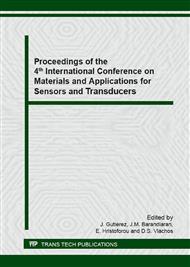p.1
p.4
p.8
p.12
p.16
p.22
p.26
p.31
p.35
Electronic State and Piezoresistivity Analysis of Zinc Oxide Nanowires for Force Sensing Devices
Abstract:
The piezoresistivity for force sensing in wurtzite-ZnO nanowires with [0001] orientation has been simulated on the basis of the first-principles calculations of model structures. According to the difference in wall structure, our devised nanowire models can be divided into three groups by their conductivities; no band-gap conducting models, direct band-gap semiconducting models, and indirect band-gap semiconducting models. The strain responses to carrier conductivity of n-or p-doped semiconducting wurtzite-ZnO[0001] nanowire models were calculated using band carrier densities and their corresponding effective masses derived from the one-dimensional band diagram by our original procedure for a small amount of carrier occupation. The conductivities of p-type direct band-gap models change drastically due to longitudinal uniaxial strain in the simulation: the longitudinal piezoresistance coefficient is 120 × 10–11 Pa–1 for p-type (ZnO)24 nanowire model with 1% compressive strain at room temperature.
Info:
Periodical:
Pages:
16-21
Citation:
Online since:
May 2015
Authors:
Price:
Сopyright:
© 2015 Trans Tech Publications Ltd. All Rights Reserved
Share:
Citation:


